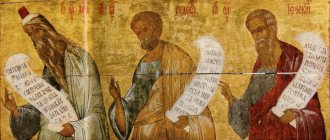“Jacob Wrestles with God” Alexandre Louis Leloir, 1865 The Big Bang, which suddenly occurred about 13.8 billion years ago, marked the beginning of history. Several billion years after this, galaxies formed from clouds of slightly cooled gas; after some time, stars formed from nebulae inside the galaxies, and planets appeared around the stars. On one of these planets, chemical life arose in the water near the hot hills of underwater volcanoes. Gradually, this life became more complex and evolved - first into the simplest viruses and bacteria, and then into birds and mammals. And in the end, the brain of one of the species of mammals developed enough to, based on indirect evidence, reproduce the entire path it had taken to its own existence. But despite all its achievements, this mammal is still tormented by the question: what happened before the Big Bang?
Opinions differ on this matter. Many consider this question to be incorrect, since time itself did not exist before the Big Bang. Some consider our Universe to be the interior of a black hole formed in some “outer” Universe. And some believe that everything that exists is a simulation running on a powerful computer in the “real” world. Who knows, maybe our whole world really is just a school programming project for a sixth-grader from a developed civilization. But even if our world is inside the “superuniverse” or “real universe,” then why does this external universe itself exist? What gave birth to it? Why does everything exist at all?
Creator
The most popular answer to this question has long been considered the existence of God, the creator of our world. Proponents of this point of view view the Big Bang directly as an act of Creation.
The logical chain of reasoning leading to proof of the existence of God is called a cosmological argument. It says that since the law of cause-and-effect relationships strictly operates in the world and everything has a cause, then the world itself must also have a cause, and such a root cause is God.
True, the existence of God gives rise to a logical question: where did God himself come from in this case? In response to this, medieval Christian scholastic theologians argued that the question “what was before” and “where did it come from” is not applicable to the concept of God, because God is an absolute outside of time and space. Therefore, in a strictly formalized form, the cosmological argument looks like this:
- Every thing in the universe has its cause outside itself (children have a cause in their parents, a rolling ball has a cause in the person who pushed it, etc.)
- The universe, as consisting of things that have their cause outside themselves, must itself have its cause outside itself
- Since the universe is matter existing in time and space, therefore, the cause of the universe must be outside these categories
- Therefore, there is an immaterial cause of the Universe, not limited by space and time
- Such a root cause can be called the word “God”
The doctrine of an eternal and infinite God, who created all things, and the cosmological argument itself were not the original ideas of Christian theologians, they were not even created by Christians themselves. The whole point is that despite the fact that Christianity in the religious aspect is a product of Judaism, in the ideological aspect it is a direct descendant of ancient Greek philosophy.
Parmenides - being and non-being
Parmenides
The ancient Greek philosopher Parmenides did not ask the question of why everything that exists (“being”) exists. He considered a much more interesting question: does non-existence exist? His train of thought, pardon the pun, revolved around the thought itself.
About being, Parmenides argued that its existence is absolutely self-evident for us, since only what we think already speaks of the existence of something - thought itself. Many centuries after Parmenides, the famous French philosopher Rene Descartes formulated this statement most succinctly: “I think, and therefore I exist.”
Regarding non-existence, Parmenides argued that it does not exist because it is unthinkable. If you try to imagine nothingness, then most likely you will imagine absolute blackness and emptiness. But blackness is just our idea of the absence of light, and emptiness is our idea of the absence of objects. Real non-existence is the absence of anything at all: space, time, matter, even thought itself, complete oblivion. This is impossible to imagine, and therefore, according to Parmenides, non-existence does not exist. In addition, the philosopher noted that the existence of non-existence is logically contradictory, because it comes down to the statement “There is something that does not exist.”
From the existence of being and the non-existence of non-being, Parmenides draws two conclusions: that being is not generated by anything, otherwise it would have to admit that it came from non-being, which does not exist, and that being is eternal and indestructible, otherwise it would turn into nothingness that does not exist. As can be seen, already in the time of Parmenides, views about a certain eternal absolute, having neither beginning nor end, began to form in Greek philosophy.
In addition, from the existence of being and the non-existence of non-being, Parmenides deductively derives a picture of the world very similar to modern ideas about our Universe, which the philosopher also calls being:
- There is one being, and there cannot be two or more beings, otherwise they would have to be delimited from each other by non-existence, but it does not exist
- Being is continuous and united, that is, it has no parts. If existence had parts, they would be delimited from each other by non-existence, but it does not exist
- Being is motionless, homogeneous, perfect and limited, has the shape of a ball
- Being has neither past nor future, being is pure present
It is unknown how exactly the philosopher came up with the idea of a spherical form of existence, but we can say with confidence that he guessed the real shape of our Universe.
Kant and faith
From Kant's biography it is clear that he treated religion with absolute indifference. From childhood, he was brought up on an understanding of faith (Lutheranism) in the spirit of pietism, a widespread movement at that time that arose in Germany at the end of the 17th century as a protest against the degeneration of Lutheranism. He was against church rituals. Pietism was based on conviction in the subject of faith, knowledge of the Holy Scriptures, and moral behavior. Pietism subsequently degenerates into fanaticism.
He subsequently subjects the children's pietistic worldview to philosophical analysis and severe criticism. First of all, it went to the Bible, which Kant considered nothing more than an ancient text. Further, the concept of “salvation” is criticized. Lutheranism, as a movement of Christianity, makes it dependent on faith. Kant perceives this as an insufficiently respectful attitude towards the human mind, a limitation on his self-improvement.
I would like to immediately note that philosophical proofs of the existence of God, including those discovered by Kant, are the subject of European philosophy and papal Christianity. In Orthodoxy, no attempts were made to prove the existence of God. Since belief in God is a matter of personal belief, no proof was required.
Pythagoras - the cult of the unit
Pythagoras
Shortly before Parmenides, another ancient Greek philosopher and mathematician, Pythagoras, lived in Greek Italy, and is still known today for his famous theorem on the relationship between the lengths of the legs and the hypotenuse of a right triangle. Pythagoras was delighted by the relationship he discovered between the height of the sound produced by a harp and the length of its strings - after this discovery, Pythagoras created the first mathematical theory of music in history. Seeing that other laws of nature, like music, are described by mathematics, Pythagoras put forward the hypothesis that mathematics underlies everything that exists, or, in other words, that “everything is a number.” By analogy with music, Pythagoras called the mathematical beauty of the world order the great harmony of the Universe.
Pythagoras adored numbers, he was especially fascinated by the unit - Pythagoras called it a monad and worshiped it, considered it the highest absolute, a symbol of the single and indivisible fundamental principle of all things, a deity. Pythagoras considered the two to be the principle of the bifurcation of all things into opposites: the limiting and the infinite, the even and the odd, the one and the multiple, the right and the left, male and female, rest and movement, straight and crooked, light and darkness, good and evil.
This belief led Pythagoras to create his own religion. Having collected ideas from the monotheistic religion Orphism, which was popular in Greece at that time, he created the Pythagorean school - a religious and mathematical interest group. The Pythagoreans worshiped the One, and they chose the Sun as the material embodiment of the One. The Pythagoreans looked for their sins and made confessions. According to ancient historians, Pythagoras punished his disciples: “Let the sleep that closes your eyelids not touch your eyes before you have sorted out the affairs of three days in order: “What have you sinned?” What did you do? What did I not do that was due?” Despite the mathematics of the Pythagorean school, they had many prohibitions and superstitions: Pythagoreans were forbidden to eat beans, step over the crossbar, touch white roosters, look in a mirror near the fire, break bread and much more. They also practiced vegetarianism, since they inherited the doctrine of the transmigration of souls from Orphism.
The Pythagorean hypothesis about the mathematical structure of the Universe became very popular among scientists - Newton, Kepler, and Einstein were inspired by it. This hypothesis is confirmed even in modern scientific research. If we look at quantum mechanics, which describes our world at the micro level, we will see that there the solid material world crumbles into pure mathematical abstractions: Hilbert space, complex numbers, Schrödinger wave equations, tensors and linear operators.
Cracks in the walls
Although attractive, this proof has serious flaws, noted by both Hume and later philosophers. Among the most important we note the following:
- The analogical argument works if two things are sufficiently similar in several known important respects to suggest that they are similar in other respects as well. The physiology and behavior of humans and chimpanzees are similar enough to suggest (but not categorically state) that chimpanzees, like humans, are capable of experiencing pain. A proof by analogy depends on the degree of similarity of the objects being compared. But there really isn't much in common between human-made objects (a camera, for example) and natural objects (the eyes of mammals, for example), so any conclusions drawn in this way are not very convincing.
- Teleological proof is fraught with the emergence of a situation of infinite regression. If the amazing perfection of the Universe requires the presence of a creator, then even more so a creator is required for the combination “Universe plus creator”! If there is a creator, then a supercreator will be required, and then a supersupercreator, and then... Thus, if the denial of regression is the essence of the cosmological proof, in the teleological proof regression seems to be a necessary evil.
- One of the main arguments in favor of this evidence is the ability to explain the origin of natural wonders. But Darwin's theory of evolution by natural selection perfectly explains all these phenomena and the perfect conformity of living forms to their natural functions, without any intervention of a supernatural creator. The divine watchmaker was fired, and a blind master, evolution, was hired in his place.
- Even if we recognize the act of creation, we will have to recognize the boundaries within which the Creator acted. Many creatures of nature speak rather in favor of collective creation by a whole team of gods. In addition, the wonders of nature, which at first glance inspire awe, upon closer examination turn out to be not so perfect at all; it turns out that a flaw in creation reflects the shortcomings (non-omnipotence) of the creator? And in general, the amount of evil in this world makes one doubt the moral qualities of its creator. And of course, there is no reason to believe that the creator, if there was one, is still alive.
Plato - the eternity of the soul
Plato
Another famous ancient Greek philosopher, Plato, had great respect for Pythagoras and mathematics. Above the gates of the academy he founded in Athens, he wrote the phrase that went down in history: “Let no geometer enter.” But most of all, Plato is famous for creating the doctrine of ideas. Strictly speaking, this teaching began to be formed by Plato’s teacher, the famous Athenian philosopher Socrates, but it was Plato who developed it into the philosophy now known as idealism. The easiest way to understand Plato's “idea” is through the following example.
There are many round tables in the world, but none of these tables are perfectly round. Some of the tables have small cracks and imperfections, some are well made but are still not completely round at the atomic level. Despite this, we have the idea of a perfect geometric circle in our heads. That is why we usually call such a circle ideal. In addition, there are a great many tables of different shapes in the world, but in our minds there is an abstract idea of a table, under which all the tables existing in the world fall. Thus, an ordinary round table in the material world, according to Plato, has a prototype in the world of ideas: the idea of a round table, which is a combination of the idea of an abstract table and the idea of a circle.
The best examples of Platonic ideas are mathematical objects and relationships. If we think about whether two plus two would equal four if no universe existed at all, then we will come to the conclusion that yes, it would. After all, this equality is not something material and dependent on some properties of the universe - it exists only in the world of ideas. Moreover, we can endlessly combine different ideas and their combinations, generating more and more complex ideas. Thus, Plato comes to the conclusion that the world of ideas, unlike the material world, is eternal and infinite. In addition, according to Plato, the world of ideas, despite all its diversity, is something One.
Developing this idea, Plato asks the question: if our mind, or figuratively speaking, the soul, is the sum of a huge number of ideas, and ideas are eternal entities, then it turns out that our soul is also neither born nor dies. Plato believed that after physical death, the human soul returns back to the world of ideas and achieves complete unity with it. This is how Plato comes to the doctrine of the immortality of the soul and its posthumous return to God, which will later be adopted by the fathers of the Christian church.
Kant's proof
Moral (spiritual). Having carried out a critical analysis and proven the fallacy of classical proofs, the philosopher discovers something completely new, which gives, to the surprise of Kant himself, six proofs of the existence of God. No one to this day can either confirm or refute it. The brief gist of it is as follows. A person’s conscience, living inside him, contains a moral law that a person cannot create himself; it also does not arise from an agreement between people. Our spirit is closely connected with God. He is independent of our desire. The creator of this law is the supreme legislator, regardless of what we call him.
For its observance a person cannot desire a reward, but it is implied. It is laid down in our spirit by the supreme legislator that virtue receives the highest reward (happiness), vice - punishment. The combination of morality with happiness, which is given to a person as a reward, is the highest good that every person strives for. The combination of happiness and morality does not depend on a person.
Aristotle - creation of the material world
Aristotle
Plato's student, philosopher Aristotle, analyzing his teacher's thoughts about the world of ideas, asked the question: if the prototypes of real material things are ideas, then what forged our material world according to the patterns of ideas, what breathed life into ideas, materializing them? Aristotle considered the existence of a Prime Mover to be the only reasonable answer to this question. It was Aristotle who first formulated the cosmological argument - if everything has a cause, then there must be a very first cause, the beginning of every action in the world - the Prime Mover. Thus, Aristotle completes the formation of the image of God, which was later adopted by Christians - the eternal and infinite, immaterial Absolute and Prime Mover of all things.
Fifth
Theological proof. Everything in the world exists in a certain order and harmony, the emergence of which is impossible on its own. This suggests that there is some kind of organizing principle. This is God. Plato and Socrates saw the highest intelligence in the structure of the world. This proof is usually called biblical.
Brahman
In the ancient Indian philosophical school there was a concept of the One similar to the Greek one - the Indians called it Brahman. They believed that our entire world in all its diversity: every leaf on a tree, every pebble on the ground, every living creature, every moment of time, are particles of a certain superbeing - Brahman, and all physical, chemical, biological and historical processes in The Universe are the life processes of this super being. This being is not a personal God, Brahman is rather the soul of the world, an indifferent absolute, it is directly reality itself. This creature did not appear from anywhere, and will not disappear anywhere, it is existence itself. They argued that Brahman cannot be given any affirmative definition, it can only be defined through negation: Brahman is infinite, Brahman is unchanging, Brahman is motionless. The ancient Indians, who believed in Brahman, were the first pantheists.
It is interesting to note that the famous physicist Erwin Schrödinger was an ardent admirer of the Indian philosophical school of Vedanta and wrote an entire treatise on the connection between quantum mechanics and Brahman. But unlike Schrödinger, not all philosophers of ancient India agreed with the idea of Brahman, and one of them will be discussed further.
Proofs of the existence of God in the philosophy of Leibniz. METAPHYSICS
Leibniz gives in their completed form metaphysical proofs of the existence of God. They have a long history; they were started by Aristotle or even Plato; they were formulated in complete form by the scholastics, and one of them - the ontological proof - was created by St. Anselm. This is proof, although it was rejected by St. Thomas, was revived by Descartes. Leibniz, who reached the highest heights in the art of logic, formulated the proofs better than they had ever been formulated before. That's why I consider them in connection with it.
Buddha - Dependent Origination
Siddhartha Gautama - Buddha Shakyamuni
During the time of Pythagoras and Parmenides, at the other end of Indo-European civilization lived the great Indian philosopher Siddhartha Gautama, better known as Buddha Shakyamuni. The central idea of his philosophy was shunyata - the underlying emptiness.
Buddha argued that absolutely all things (objects and phenomena) in the world are composite, that is, they can be decomposed into two or more parts. The interaction of these parts gives rise to the illusion of the existence of this thing itself; the thing has no properties of its own - its nature is “empty” . For example, a hydrogen atom consists of a proton and an electron, and all its properties are generated by the interaction of these elementary particles. The hydrogen atom itself is just an idea in our head; in fact, there is no atom, there is only the interaction of a proton and an electron.
The Buddha pointed out that when the composite things themselves interact with each other, more and more complex composite things are generated, and there is no limit to this. Just as the interaction of elementary particles generates atoms, the interaction of atoms generates molecules, the interaction of molecules generates cells, the interaction of cells generates living organisms, and the interaction of living organisms generates ecosystems and civilizations. The philosopher wisely noted that all composite things and phenomena are short-lived, tend back into the void and, sooner or later, disappear into oblivion.
In addition, the Buddha pointed out that things and phenomena arise around emptiness only interdependently and symmetrically. For example, the concept of low arises mutually with the concept of high, the concept of stupid arises mutually with the concept of smart, day arises mutually with night, heat with cold, light with darkness, past with future, cause with effect, wakefulness with sleep, and a slave can exist only with the existence of the owner.
Shunyata is closely related to mathematics - the Indians called the number “zero”, invented in the eighth century AD, by the Sanskrit word “shunya”, which means “empty”. In addition to the main meaning of zero as emptiness, that is, the absence of countable objects, this name emphasized the sacred meaning of zero: just as according to Indian philosophical ideas, emptiness lies at the basis of all things, so zero lies at the very foundation of all mathematics. It is relative to zero that positive and negative numbers mutually arise.
We can also find confirmation of the philosophical views of the Buddha in the physics we know. Forces such as gravity and electromagnetism occur between two objects only reciprocally - both objects attract each other or repel each other with the same force. In the case of electromagnetism, pairs of positively and negatively charged particles also exist symmetrically. And so everything tends back into emptiness, towards zero, then differently charged particles attract each other, and equally charged particles repel.
According to the laws of quantum physics, even in a vacuum, energy cannot be constantly zero. It constantly fluctuates and is zero only on average. Zero-point oscillations of the polarized vacuum constantly generate symmetrical pairs of virtual particles and antiparticles. When they collide, particles and antiparticles annihilate, returning back into the void.
There is the zero-point energy hypothesis of the universe, which states that the total amount of energy in the universe is zero because the amount of positive energy in the form of matter is equal to the amount of negative energy in the form of gravity. And according to Noether’s theorem, each conservation law corresponds to some continuous symmetry of a physical system: thus, the law of conservation of energy corresponds to the homogeneity of time, and the law of conservation of momentum corresponds to the homogeneity of space.
Symmetry in general is one of the main properties of our Universe: galaxies have axial symmetry, spherical stars and planets are spherically symmetrical, most living creatures on our planet are bilaterally symmetrical, there are even creatures like siphonophores that form colonies with sliding symmetry. Moreover, we like symmetry subconsciously: most of human art, architecture, painting, sculpture, photography, music is characterized by symmetry in one form or another.
If we apply the Buddhist principle of dependent arising to the issue of being and non-being, we see that non-being simply cannot exist without the existence of being. They must coexist symmetrically. Even purely logically, both for the definition of “not A”, “A” must be defined, and for the existence of non-existence, being must necessarily exist. Moreover, we can say that Plato’s world of ideas and our material world also arose interdependently and symmetrically.
| Evidence for the Existence of God [email protected] https://mivmiv.narod.ru/ |
Historical and logical information
To avoid misunderstandings, I would like to emphasize that here we understand God as he is depicted in Christian dogma, but we do not endow him with specific biblical features. It is in the form of prose that their natural shortcomings are clearly visible, which the romantic “Theological Poem” would like to hide. In total, I counted five possible (try to think of something else!) proofs of the existence of God: cosmological (K), teleological (T), ontological (O), ethical (Et) and aesthetic (Es). Each of them can be given at least two forms, slightly different in logical content: “folk” and “philosophical”. Thus, we will have at least 10 proofs, since the difference is manifested in the very way of reasoning. In his “Critique of Pure Reason” Immanuel (translated: God is with us, which is funny) Kant analyzed the first three proofs, and considered K.d-vo and T.d-vo (the latter in the Russian translation is called physical-theological) only veiled shell O.d-va. Indeed, O.d-vo, in the words of A. Schopenhauer, which looks like a cute joke, childish play for philosophers, lies at the basis of all proofs. In essence, it is stated: “There must be A, but without B A is impossible, and B, naturally, is God. Therefore, God exists." However, in the Critique of Practical Reason, Kant gives an Et.d. that suffers from the same drawback. K.d-vo was known back in antiquity (see, for example, Augustine’s “Confessions”). Its philosophical form was first proposed by Leibniz; in the 20th century, Wittgenstein sympathized with this reasoning. Etc., although its origins, as it seems to me, lie in the biological worldview of the ancients, was clearly formulated by the scholastics. I would call both of these two natural sciences, since they tend (in a “folk” form) to refer to our knowledge of the world. Kant, who was amazed by the “starry sky,” spoke with respect about T.d., but, unfortunately, was completely disdainful (it does not deserve it!) Treated T.d., whose author is recognized as the medieval bishop St. Anselm Canterbury. O.d-vo and the two subsequent ones (Et. and Es. d-va) I classify as humanitarian evidence. They appeal not to the mind, but to the heart. Es. d-is not covered in any way in the literature, I only have a famous quote from Shakespeare on this subject, and also as an antipode to the thoughts of A. Camus and existential philosophy in general about the meaning of life. I’ll probably be corrected, but I can safely say: I’m the only one who clearly formulated it for the first time. If anyone can add this information, I kindly ask you to let me know by means of a guest book and e-mail.
Cosmological proof
PEOPLE FORM: Every event in the world has a cause in a previous event in time. This event is in turn caused by another event. Thus, every event on Earth has one of its causes the fact of the geological formation of the Earth as a planet (5 billion years ago). This chain of causes can be continued until the time of the Big Bang (less than 20 billion years ago). Further, it is no longer scientific to ask the question of what happened BEFORE the Big Bang, what (or who) was the cause of the formation of the world (we don’t know whether there are other Universes). Taking into account the law of conservation of momentum, one can ask about the Prime Mover, which gave all matter the initial impulse. A philosopher can ask these questions to himself and, refusing to go into “bad infinity,” postulate the presence of a root cause. The root cause is self-sufficient, it does not need other reasons for its existence, it is the cause of itself. This first cause is God, the Almighty, the Creator. PHILOSOPHICAL FORM: It seems that we can confidently assert, based on empirical experience, that there is matter, space, time, physical laws that matter follows in its movement. Even a solipsist must agree that there is some idea that he fantasizes about. In any case, we can conclude that there is SOMETHING that we call the world. I can easily imagine that the paper on my desk is missing; she is not there, and instead of her there is nothing. I can imagine, although with difficulty, that all the things around me are missing, even distant stars. It is logically possible (theoretical) that there is no world, nothing at all, not even me. However, the first, positive possibility is undoubtedly being realized. Why is that? There is a single source (GOD), who performed (or is performing!) an act of creation, thanks to which NOTHING was replaced by SOMETHING.
REFUTATION: For example, why not, as the ancient peoples thought, accept the eternal existence of the world in time, an endless chain of causes in both directions. In addition, we may well ask about the cause of God (a self-sufficient cause is a vague concept, it cannot be imagined). Finally, we can accept Kant's point of view on time, which is only an a priori form of sensory perception. Moreover, the very concept of “cause,” as Hume wrote, is imagined by us to reality and is the result only of our habit. Philosophical and folk forms are equally vulnerable in this regard, although the former does not use the concept of time, it speaks of a logical rather than a physical cause.
Thus, the cosmological proof of the existence of God asks the question: WHY does the world exist? Only in popular form is it given at the very end of the proof after constructing a chain of causes, and in philosophical form, almost at the beginning. The price of rejecting K.d-va is the recognition of the limitations of our logical ability to understand the world.
Teleological proof
PEOPLE FORM: Our everyday experience, for example, in the form of our own body, indicates the expediency of the structure of nature. The cat's paws are soft to make sneaking easier. It is difficult to believe that such proportionality of the parts of individual living and non-living (crystals) things arose by itself and would be purposeless. The world itself, by the order that prevails predominantly in it (the sun rises and sets every 24 hours), testifies to the divine plan. We need an Architect who improves our world, who is God.
PHILOSOPHICAL FORM: The second law of thermodynamics and the phylogenetic study of life on Earth indicate the inequality of the past and the future (although they say the opposite). There is progress in the self-organization of matter. However, is self-organization so universal in space? Here are the facts: a) life has been discovered only on Earth (it is not found on the planets of the solar system; only Mars is in doubt); b) non-carbon forms of life are chemically impossible; c) listening to space radio signals gave a negative result; d) the random birth of the first cell (Oparin’s theory) requires on AVERAGE too much time to sort through options (100 billion years more than the age of the Universe); e) the problems of Darwinism in explaining sudden evolutionary changes (Darwinism explains the continuity of phylogeny quite normally); f) human society also progresses, just like humans. Where Darwinism encounters the inexplicable in its attempt to justify the existence of life on Earth, it must assume the intervention of God. Science may be powerless to explain the progress of life on Earth as a whole. Let us assume that the theory of self-organization triumphed and was able to indicate the reasons for the existing order. The entire world evolutionary process is carried out FOR something. There is One who set a goal for him, and for this purpose established such physical laws that would allow the appearance of an observer in the world (the anthropic principle in cosmology), i.e. God.
REFUTATION: The folk form we have inherited from ancient times emphasizes the existence of order (structure); the philosophical form emphasizes evolution (process). The anthropic principle of modern cosmology is in a sense the revival of a folk form. This proof, since the theory of self-organization of matter does not completely answer all questions that are exclusively scientific in nature, has a chance to be TRUE. Thus, the teleological proof poses two questions, as if in one: why is the world the way it is? WHY does the world exist? To the first, let’s accept an alternative answer: the world is given to us in a single copy, and if it is SUCH, then it is not our fault, these are the prevailing laws in it, it makes no sense to ask why they are EXACTLY like this. The second question is easier to answer: it is the human habit of utilitarianism that forces us to ask it. In addition, if the process has no end, then it is pointless to ask about its purpose (see K.d-va’s refutation). The psychological origins of T.d. apparently lie in our habit of a utilitarian attitude towards the world. Rejection of T.d. leads to denial of the purpose of evolution and, in particular, the history of mankind.
Ontological proof
NATIONAL FORM: Many ancient peoples had an idea of God. Despite the vagueness of this image, millions of people believed in it in all historical eras. Even most modern Nobel Prize winning scientists who are most associated with natural science have retained their belief in a supreme being. There is no other explanation for this except that God really exists. PHILOSOPHICAL FORM: In nature we notice many stages of increasingly more perfect creatures: from inanimate stone to living man. It is therefore possible to imagine an absolutely perfect being. This is the ideal of all ideals that a person can imagine. Among its attributes, in addition to “kindness”, “wisdom”, “strength”, “beauty”, it (the creature) certainly contains the attribute of “existence”. Otherwise, since “to be” is better than “not to be,” it would suffer a decrease in its perfection, i.e. would not be absolutely perfect. Therefore, God exists as an absolutely perfect being.
REFUTATION: Both forms of proof are refuted if only by the fact that not everything we think exists in reality. In no way can “existence” fall into signs or attributes (Kant’s example with a hundred thalers). The popular form is essentially a reference to authority, as well as the impossibility of misleading the majority. Both are wrong: the wise can think incorrectly (for example, the Ptolemaic system), and the majority tend to be guided by emotions (for example, the conformity of a person in a crowd). On the other hand, cultural studies thereby raises the question of the origin of the phenomenon of mass religion, including in our time. Someone pointed out the specifically human need to “believe in something”, which distinguishes him from the animal. To the defenders of the popular form, I note that no less wise people and an even greater number of people did not believe in either God or the devil. I will also object to the defenders of the philosophical form by saying that: a) it is still necessary to prove the consistency of the “ideal of all ideals”; b) the concept of “perfection” is rather vague; c) “being is better than non-being” is an unproven position. The price of denying O.d-va is the recognition of the futility (in the sense of realization) of all the dreams of any person (both the author and the reader, yours!) that go beyond the earthly.
Ethical proof
PEOPLE'S FORM: Our observations of the lives of the people around us show that some experience almost only bright moments, while the lot of others is covered in the darkness of sorrows: some become powerful, for example, heads of corporations, others struggle all their lives with poverty for a piece of bread, collecting bottles. Such a difference in people's destinies cannot be accidental. Even the everyday experience that society gives us convinces us that good brings good fruits, and evil brings only evil. Justice, present in the soul of even a criminal, tells him: “For the evil committed there must be punishment, for the good deed committed there must be a reward.” However, sometimes we see how this is violated, and the evil person who is subject to condemnation, on the contrary, triumphs. Consequently, there is a mechanism that implements justice (for example, punishment in the afterlife). This mechanism is either God himself or is put into action by him.
PHILOSOPHICAL FORM: Since there is Good, the necessary conditions for its existence must be met. In relation to an individual, they consist in his happiness and his worthiness to be happy. There is no good in the fact that a person would live happily, but would be unworthy of it (for example, at the expense of loot). There is also no good in the fact that a person would be deprived of happiness, although he did everything to be worthy of it (for example, a philanthropist and patron of the arts, patronizing the hungry and people of art, died in terrible agony from cancer). Natural physical laws inherent in nature, and which we cannot change by will, only randomly ensure the simultaneous fulfillment of both of these conditions. More precisely: good will, which must be realized for human happiness and in fulfillment of the law of justice, requires the existence of God in order to circumvent empirical restrictions. Therefore, God exists.
REbuttal: Both forms of evidence agree that justice (judgment) must be done. The philosophical form, however, starts from the idea of the Good (the popular form, in essence, from emptiness, because in experience justice is very, very, too often violated). It also shifts the emphasis towards reward, and punishment is understood only as the denial of happiness. This d-vo is refuted in the same way as O.d-v, you only need to substitute “justice” instead of “all-good being”. Let us even assume that a mechanism for realizing justice exists. However, as Buddhism and its idea of karma shows, this does not necessarily entail God. This does not even lead to the recognition of the immortality of the soul: in the Old Testament, sins passed from father to son up to the seventh generation, i.e. the punishment was collective. Regarding justice, taking into account the complexity of the concept of cause, I will make one remark: retribution can precede in time the committed act (or intentions). The general course of Et.d-va, however, does not change from this. The psychological and historical origins of this ethos seem to me to be that throughout history, humanity has suffered too much (including its most sensitive representatives). Suffering from inanimate matter (hunger, for example) helps to transfer the thought of future joys, since according to the law they must compensate for current deprivations. Forced suffering from other people (violence, for example) is endured by the thought of divine vengeance on the villain, because revenge “here” is objectively impossible due to particular empirical conditions. The price of refuting this evidence is the loss of personal motivation to commit moral actions.
Aesthetic proof
FOLK FORM: How beautiful the evening sky is at sunset! How full of grace is a cat stalking its prey! How mysterious human behavior is sometimes! The temples, towers, outfits he created are truly wonderful... It is also fascinating to watch the historical movements of peoples, the fall of empires, the birth of heroes... In the end, it is interesting to see the progress of a chess game, a football match, or the intrigue of some computer game. As we know, any theatrical performance has its audience. It cannot be that such a magnificent, multifaceted spectacle that this world is does not have an absolute Spectator, capable of observing the “play” from any point of view. Nothing will pass by his contemplating gaze. This Spectator is God.
PHILOSOPHICAL FORM: Every thing in the world has its own value. The world as a whole must also have value. This value would be diminished if only one (in particular, its final) state were taken into account. Moreover, the connection between these states is also valuable. We need consciousness that “connects” our world into one idea, and, in addition, gives this idea value, even if only aesthetic. This absolute consciousness (since everything is represented to it at all times) belongs to God, therefore God exists. REFUTATION: Both forms are broken by the fact that the representation is not at all obliged to have a Spectator (or a value, which, by definition, requires its creator). Not everything that is worthy of being contemplated has an observer (cf. Et.d-v), i.e. contemplated. Since I consider myself the author of at least the philosophical form of Es.d-va, I will make two comments: 1) Es should be differentiated. and T.d-va, since the first speaks about the meaning of the world in general, and the second speaks about the ultimate goal of the world; 2) absolute value is an aesthetic (disinterested) value, since otherwise it would be utilitarian, i.e. required a higher value for its justification, and, therefore, would not be absolute (cf. K.d-vom). Es. and etc., in addition to this, they turn to completely different abilities of the human soul: the first - to the artistic (including the need for self-expression), the second - to the logical (the question “WHY” becomes in a philosophical form, and the past links of the process are neglected in a purely utilitarian way; it becomes the question “WHERE DOES ORDER COME FROM” in folk form). The cost of rejecting Es. D-va consists in destroying the last attempt to give meaning to the world (beauty no longer saves the world, to paraphrase F.M. Dostoevsky).
Afterword to the evidence
Formally speaking, a person can say “YES” to one piece of evidence and “NO” to another piece of evidence, i.e. every proof produces its own God, and we have five different gods, distinguished by only one distinguishing feature. Since “entities should not be multiplied beyond what is necessary,” it is methodologically correct to speak of one (the Christian God) having a totality of five attributes. Consequently, both methodologically and psychologically, from the acceptance of one piece of evidence, the acceptance of four other pieces of evidence (more precisely, signs) follows. This is the worldview position of a transcendentalist, as opposed to the position of a materialist-atheist. One could write out these two poles like the Kantian antinomy. So, one says: “God exists, he is the creator of the world, he has a Plan (providence) regarding his creation and, in particular, humanity; being absolute Perfection, he gives us the opportunity to get closer to him, punishes the evildoers and has mercy on the righteous, his attention is completely absorbed in what is happening in the world.” The second says: “The world is self-sufficient, the emergence of man in it is only one of the stages of the evolutionary process laid down by nature itself and has no particular significance; all human aspirations are the languor of his spirit, a consequence of the bends of his psyche, and in his actions he needs to be afraid only of the ricochet of the laws of physics and, in some cases, social and legal laws; the world itself as a whole, humanity in general and man in particular are devoid of all meaning.”
Thus, in practical life, a transcendentalist has every chance of becoming a kind, socially useful, happy person. A consistent atheist who defends his position could potentially be called (and he sometimes calls himself this) an immoral monster. Everything depends on two acts of choice made by a person in a theoretical (usually conscious) and practical (usually unconscious) relationship. Knowing this evidence (and its rebuttals) may influence this choice. However, it's up to you!
Nagarjuna - reality and unreality
Nagarjuna Statue in Scotland
A few hundred years after the death of Siddhartha Gautama, another Buddhist philosopher, Nagarjuna, pondered the question: can we even find differences between the ideal and material worlds and tell what is real and what is not?
Let's take for example the already mentioned hydrogen atom. Since this atom is just an illusion generated by the interaction of a proton and an electron, and exists only in our head in the form of an idea, it means that it is not part of the material world, which means it is unreal. But everything else in our world is built from atoms—molecules, cells, organisms, planets—and is a collection of layers of abstractions of component ideas. This means that all material things are also unreal. Moreover, even the very nucleus of an atom, the proton, is a composite illusion of the interaction of quarks, and an electron spinning in orbit around a proton can be represented as an illusion generated by the interaction of physical forces described by mathematical formulas. That is, the parts of the atom are also illusory and unreal and exist only as an idea in our head.
Even such a seemingly fundamental property of our Universe as time is just an illusion. We divide time into past, present and future. The past is defined in relation to the present and the future, the future is defined in relation to the present and the past, and the present is defined in relation to the past and the future. The past no longer exists, the future has not yet arrived. So where then is the present - that very moment between the past and the future? Between that which no longer exists and that which does not yet exist. This means that the present and time itself are just as “empty” as everything else.
Of course, in the time of Nagarjuna, they had not heard of quarks, but having analyzed in a similar way all the things and phenomena known to him, the philosopher came to the conclusion that nothing real and material exists at all, that all matter is just ideas and impressions in our consciousness, and therefore the material and ideal world are one and the same. Developing this idea, Nagarjuna came to thoughts very similar to the thoughts of the famous 20th century Austrian philosopher Ludwig Wittgenstein that our language, in principle, cannot adequately describe reality, and all our philosophy is not reasoning about the world, but reasoning about our ideas about world. A spoken thought is a lie. Everything that is real is indescribable, everything that is described is unreal, and no other reality exists except the world of ideas.
Cosmological options
The main difference between versions of the cosmological argument lies in the different relations between the subjects on which these versions focus. The most famous version, the proof of first cause, considers simple relationships (“something is caused by something”), but these relationships can be dependence, coincidence, or explanation. The sequence of these interactions cannot be infinite, and in order to interrupt it, the initial point (for example, God) should not have any properties.
According to this proof, God must be uncaused (or be his own cause), independent, must exist, must be understandable without additional information. (For simplicity, this chapter presents the proof only in terms of causal relations.)
Tegmark - in search of God
Modern physicist and cosmologist, MIT professor Max Tegmark comes to similar conclusions. In his book Our Mathematical Universe, Tegmark reflects on the problem of Pythagoras and questions posed by two great physicists: Eugene Wigner and Stephen Hawking. Wigner marveled that mathematics was so incomprehensibly effective at describing the physics of our Universe. And Hawking thought that even if in the future we complete work on the theory of everything and obtain all the equations by which our Universe works, we will immediately be faced with questions: “Why exactly these equations?” and “What breathes life into them?”
Tegmark believes there is only one way to answer these questions. And this answer is that our entire Universe is mathematics, or rather, only one of the possible mathematical structures. According to Tegmark, existence itself is any consistent mathematical structures, of which there are an infinite number, and each such structure is a separate Universe with its own laws. In each such mathematical Universe, the interaction of its simplest parts gives rise to more and more complex substructures, some of which are so complex that they can even have consciousness and contemplate all the divine beauty of this very Universe.
It turns out that Pythagoras, Plato and Nagarjuna were right. Mathematics is truly the basis of all things, an eternal and infinite truth that exists in itself, the only reality. Mathematics is the same all-generating God that the Greeks spoke about, the same all-encompassing Brahman that the Indians spoke about.
There is a story that in the 18th century, at the court of the Russian Empress Catherine II, a dispute took place between the great Swiss mathematician Leonhard Euler and the French philosopher Denis Diderot about the existence of God. In response to Diderot's assertion that God does not exist, Euler wrote a formula on the wall and commented on the entry: “therefore God exists.”
Divine Adjuster?
Modern versions of the teleological proof are based on the astronomically small probability of the Universe developing, suitable for the emergence of life, as a result of chance. If even one of the countless variables, such as gravity in the first moments of the expansion of the Universe or its initial temperature, had been even slightly different, life most likely would not have existed.
In short, the cosmos seems to have been tuned, like a musical instrument, and this suggests the existence of a powerful “tuner.” But unlikely events do happen. It is unlikely, but quite possible, that you will win the lottery; but if you're lucky, you're unlikely to think that someone rigged your winnings - you're just lucky. The origin of life is, of course, unlikely, but only through its appearance can we understand how unlikely it is - and on this basis come to the wrong conclusion!
Share link
God's blind spots
Historically, the idea of God or many gods has often been invoked to explain natural phenomena that lie beyond the limits of human understanding and knowledge. For example, when the physical causes of weather phenomena such as thunder and lightning were not yet known, they were usually explained by the activity of God or gods.
As science progressed, human knowledge expanded and such explanations were gradually abandoned. Before Darwin proposed his theory of evolution, there was even the idea of “God’s blind spots” - gaps in the explanation of the incomprehensible order of nature were simply filled by the will of God. In the case of the cosmological argument, God retreats to the furthest reaches of human knowledge—the birth of the universe and the beginning of time. In this fortified redoubt, God is beyond the reach of scientific research. But at what cost? The kingdom of heaven has shrunk catastrophically.
Share link










